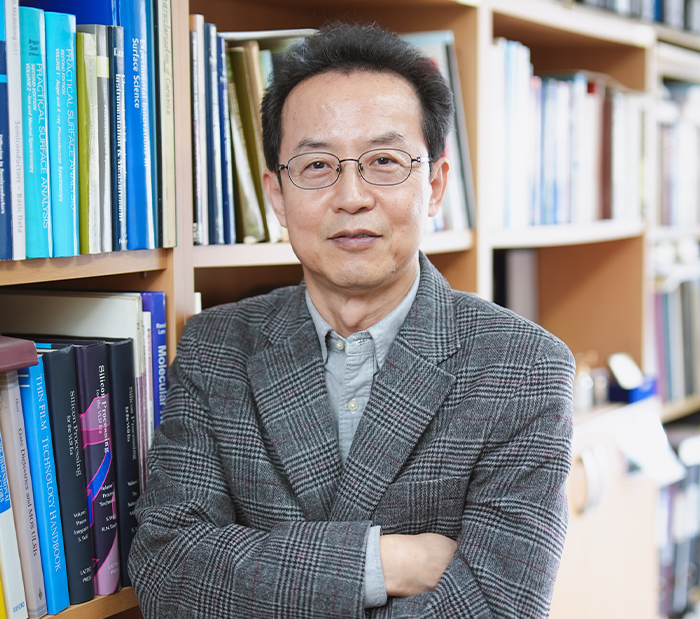Predicting and demonstrating of hidden metastable phase in transition metal oxide
Advanced Materials Science and Engineering LEE, JAICHAN Prof. · Bongwook Chung

-
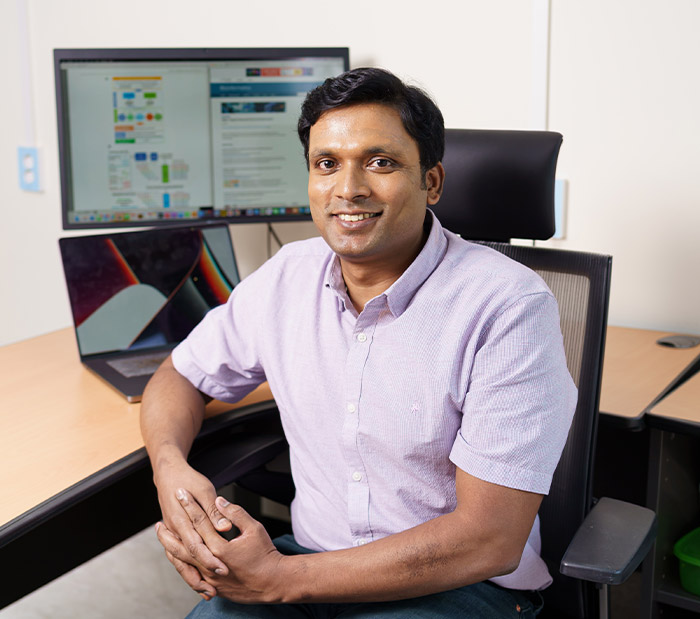
Integrative Biotechnology BALACHANDRAN, MANAVALAN Prof.
Prof. Balachandran Manavalan Proposed Cutting-edge AI-based Bioinformatics Tools
Prof. Balachandran Manavalan, Department of Integrative Biotechnology, is interested in investigating, developing, and deploying cutting-edge bioinformatics techniques using AI-based machine learning techniques in order to better understand and address a range of open and challenging problems in genomics and molecular biology. Recently, his group proposed three different novel computational methods in Molecular Therapy (Impact Factor 12.91, 2022), Briefings in Bioinformatics (Impact Factor 13.994), and Briefings in Bioinformatics (Impact Factor 13.994), respectively with him as the corresponding author. 1. Human RNA m5C Site Identification Using Stacking Strategy N5-methylcytosine (m5C) is one of the most prevalent post-transcriptional epigenetic modifications that plays an essential role in various cellular processes and disease pathogenesis. Therefore, it is important to accurately identify m5C modifications in order to gain a deeper understanding of cellular processes and other possible functional mechanisms. Prof. Balachandran Manavalan and Prof. Hong-Wen Deng (Tulane University) team developed a novel strategy to overcome limitations of the existing methods. The team constructed an up-to-date benchmarking dataset and extracted different properties from the sequences that included novel contextual one-hot encoding. Various encodings were used to construct both conventional and deep learning baseline models. A stacking approach was then utilized to combine important models for the final prediction – Deepm5C. The results show that Deepm5C significantly outperformed existing predictors for identifying m5C sites, further demonstrating the efficiency of the proposed hybrid framework. This research was conducted with the support of NRF- 2021R1A2C1014338 and the result was published online on May 06 in Molecular Therapy (Impact factor 12.91) journal, (Cell Press). 2. Human lncRNA Subcellular Localization Prediction Using Tree-Based Algorithms Long noncoding RNAs (lncRNAs) are primarily regulated by their cellular localization, which is responsible for their molecular functions, including cell cycle regulation and genome rearrangements. In the past, several ML-based methods have been developed to identify lncRNA subcellular localization, but relevant work for identifying cell-specific localization of human lncRNA remains limited. Prof. Balachandran Manavalan and Prof. Young-Jun Jeon (Department of Integrative Biotechnology) team proposed the first application of tree-based stacking approach named TACOS (Figure 1) to allow users to identify subcellular localization of human lncRNA for ten different cell types. This team conducted comprehensive evaluations of six tree-based classifiers with ten different feature descriptors using a newly constructed balanced training dataset for each cell type. Subsequently, AdaBoost baseline model’s strengths were integrated with an appropriate tree-based classifier for the final prediction. [Figure 1] An overview of TACOS. It involves the following steps: dataset construction, feature extraction, baseline model construction, and final model construction. This research was conducted with the support of NRF (2021R1A2C1014338 and 2021R1C1C1007833) and the result was published online on June 27 in Briefings in Bioinformatics (Impact factor 13.994; JCR=1) journal. 3. Novel Algorithm to Predict Anti-coronavirus Peptides Unlike conventional non-peptide drugs, antiviral peptide drugs are highly specific, easy to synthesize and modify, and not easily susceptible to drug resistance. To reduce the time and expense involved in screening thousands of peptides and assaying their antiviral activity, computational predictors for identifying ACVPs are needed. Prof. Balachandran Manavalan and Prof. Hiroyuki Kurata (Kyushu Institute of Technology, Japan) team developed a tool called iACVP (Figure 2). Based on an exhaustive analysis of five different classifiers and conventional features, the team concluded that the random forest classifier and the word-embedding word2vec (W2V) achieved the best performance, regardless of the dataset. The two main controlling factors in iACVP were: (i) the dataset-specific W2V dictionary was generated from the training and independent test datasets rather than using the Uniprot proteome and (ii) the optimal k-mer value in W2V, which provides greater discrimination between positive and negative samples. [Figure 2] Workflow of iACVP development. (A) Construction, evaluation and analysis of the ML methods with W2V encoding and BE. (B) Word2vec encoding of k-mer consecutive amino acid (AA) sequences and the sandwich structure of the training and test datasets. This research was conducted with the support of NRF- 2021R1A2C1014338 and the result was published online on July 1 in Briefings in Bioinformatics (Impact factor 13.994; JCR=1) journal. Prof. Balachandran Manavalan has developed several bioinformatics tools that have been widely used by researchers worldwide. He has published several articles in top-tier journals and is continuing to produce highly renowned research. His research interests can be found at: https://balalab-skku.org/. Currently, he is looking for talented and motivated graduate/undergraduate students with backgrounds in biological or biomedical sciences, statistics, chemistry, engineering, or computer science. Interested candidates can directly contact him at bala2022@skku.edu.
- No. 198
- 2022-08-01
- 3661
-
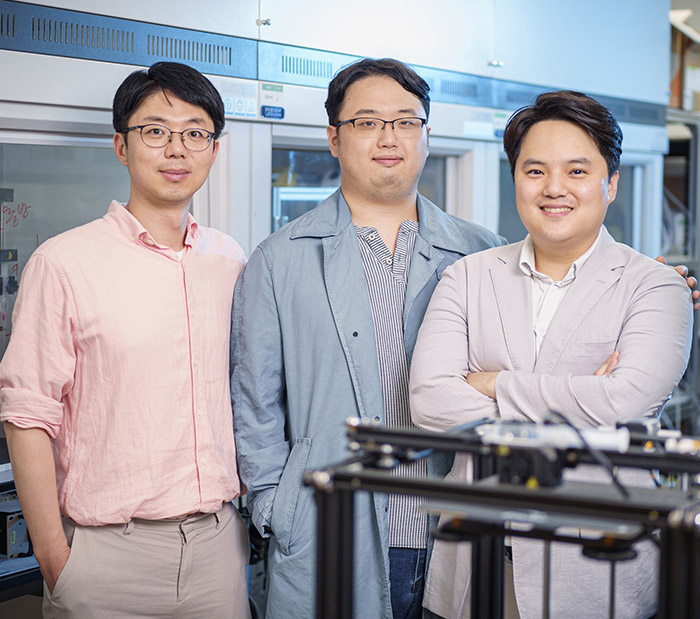
SKKU Advanced Institute of Nano Technology AN, SEONGPIL Prof. ·Prof. Ki Hyun Kim, Ph.D. Dogun Park, Ph.D. Joo-Hyun Hong
Research Regarding Eco-Friendly Wood-TENG Composed of Mechanically Durable and Biocompatible Nanofibers
A research collaboration team led by Prof. Seongpil An (co-first author: Dogun Park) and Prof. Ki Hyun Kim (co-first author: Joo-Hyun Hong) reported that they have developed a environmentally friendly wood-derived triboelectric nanogenerator (wood-TENG) composed of mechanically durable and biocompatible nanofibers. TENGs have attracted great attention because they can harness ubiquitous kinetic energies, such as vibration, friction, and impact, originated from unlimited natural resources. Not only this eco-friendly working principle, but the TENGs are also cost effective and can show high efficiency even at low operation frequency (meaning that they can harness human kinetic motions). On the other hand, in order to use these TENGs as a power source for next-generation self-powered wearable electronic devices, there are two important requirements should be considered when one fabricates TENGs. First, to harness human kinetic motion most efficiently, a geometrical structure of TENG should be efficiently designed, considering various human motions, such as bending at joints, and friction and impact during walk or running. Second, materials used for TENGs should be biocompatible, non-toxic, and skin-friendly so that they can be attached to human skin. [Figure 1] Schematic of the fabrication process and application of the wood-TENG developed. Considering these issues the research team has developed and employed the electrospun nanofibers composed of nature-derived biomaterials, in which a nontoxic biopolymer (i.e., polycaprolactone) and wood-derived extract (i.e., the root bark of Ulmus davidiana var. japonica) were included, as a tribopostive material. The wood-TENG based on these nature-derived biomaterials could generate a maximum output voltage of 80 V and also show stable cyclic energy harvesting performance during 100,000 cycles. In particular, the insole that consisted of the wood-TENG was able to generate electrical energy when one was walking and running along with showing antifungal activity against fungi existing in the foot. This research result was reported in Nano Energy (IF=19.069) at June 2022.
- No. 197
- 2022-07-26
- 1792
-
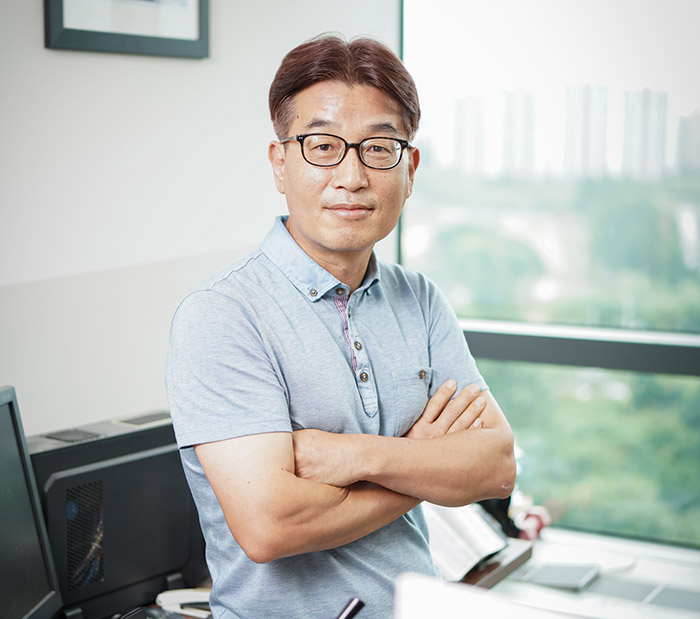
Medicine LEE, KI YOUNG Prof. ·Ji-Young Kim (SKKU College of Medicine Ph.D. student)
Identification of Genetic and Functional Roles of Stratifin (SFN) in Lung Cancer Progression
It has been reported that lung cancer development and progression are induced by genetic mutations and various external factors. Recently, lung cancer genetic data are being used to identify novel factors capable of regulating cancer development and progression, thereby providing a therapeutic strategy for the intervention of lung cancers. Various extrinsic and intrinsic factors from the tumor microenvironment (TEM) influence lung cancer progression. Recent studies have shown that toll-like receptors (TLRs) are expressed in lung cancers, suggesting that TLRs may be implicated in lung cancer progression. Although several studies have shown that stratifin (SFN, 14-3-3 sigma) facilitates lung cancer development and progression, the molecular and cellular mechanisms by which SFN is functionally involved in lung cancer progression, and the role of SFN in lung cancer progression in response to extrinsic stimulation, such as TLR agonist, are largely unknown. In this study, we show that SFN expression remarkably up-regulates in lung cancer tissues through the analyses of The Cancer Genome Atlas (TCGA) data and primary non-small cell lung cancers (n = 31 of our cohort patients). Moreover, SFN positively regulates lung cancer progression through autophagy induction by facilitating the TRAF6-Vps34-BECN1 complex in response to an extrinsic TLR4 agonist (Figure 1). Together, our clinically comparative results and functional investigations of SFN expression in lung cancer will potentially contribute to translational approaches for the development of lung cancer therapeutic agents. This study was carried out in collaboration with Dr. Eunyoung Chun's team in the R&D center at CHA Vaccine. Ji-Young Kim, a Ph.D. student at SKKU College of Medicine, contributed to this study as the first author. Article: Kim, J. Y., Kim, M. J., Lee, J. S., Son, J., Kim, D. H., Lee, J. S., Jeong, S. K., Chun, E., & Lee, K. Y. (2022). Stratifin (SFN) regulates lung cancer progression via nucleating the Vps34-BECN1-TRAF6 complex for autophagy induction. Clinical and translational medicine (IF: 11.492), 12(6), e896. https://doi.org/10.1002/ctm2.896.
- No. 196
- 2022-07-08
- 2422
-
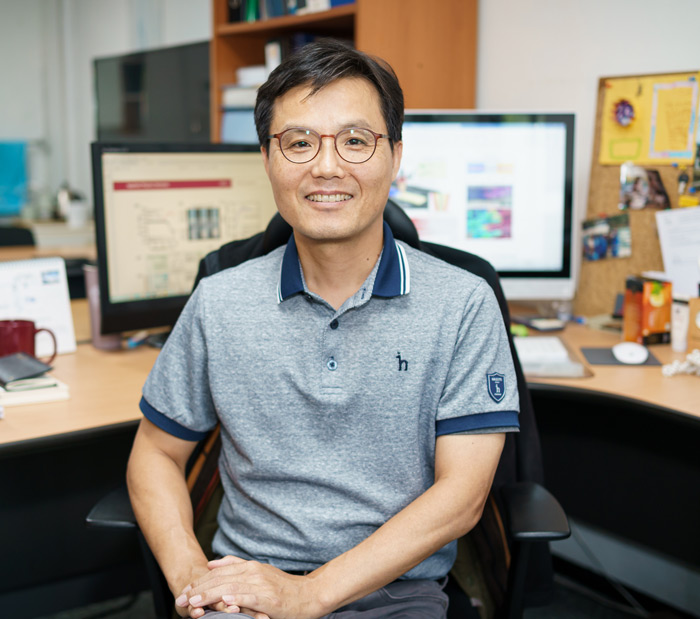
Bio-Mechatronic Engineering KIM, GEUNHYUNG Prof. ·Researcher JiUn Lee
Shape Memorable Collagen-Biocomposite Scaffold for the Biomedical Engineering Field
Shape Memorable Collagen-Biocomposite Scaffold for the Biomedical Engineering Field Scaffold-based tissue engineering aims to develop biocompatible scaffolds for the recovery of defected tissues or organs exceeding the self-healing capacity. Collagen, one of the main structural proteins in human tissues, has been widely used for the fabrication of scaffolds. However, collagen-based scaffolds prepared in vitro have limitations in that they are easily deformed by external forces. The research team led by Prof. GeunHyung Kim (first author, researcher JiUn Lee) introduced a fabrication process utilizing collagen properties for the four different types of collagen hydrogels preparation. Among the structures, two types of them showed shape memory hydrogel (SMH) properties. In the case of SMH (Cryo-gel) manufactured through a low-temperature process, the deformed structure recovered immediately after the water immersion, but low cellular activities are a limitation. On the other hand, in the case of SMH (F-gel) produced via collagen fibrillogenesis, the structure recovered slowly, but it was shown that high cell activities were promoted due to the nanofibrous structure. [Figure 1] Schematic of various types of collagen-based hydrogel In addition to reporting these characteristics, the research team developed a process to fabricate a composite hydrogel that fused the advantages of two different types of SMHs (Cryo-gel and F-gel). The fabricated shape memorable biocomposite hydrogels not only possess the fast shape recovery properties of Cryo-gel, but also have a nanofiber network similar to that of F-gel in the structure. These unique structures induced enhanced cellular activities than Cryo-gel. Furthermore, to further add the functionality of the shape of memorable biocomposite hydrogels, heparin, which is used to delay the release of growth factors, or hydroxyapatite, a major component of bone tissue, were mixed. The research team confirmed that even if these various materials were mixed, all of the produced hydrogels maintain the shape memory properties. In addition, by combining the manufacturing process with 3D printing technology, it was shown that a 3D structure could be printed. The deformed 3D printed scaffold could be recovered to its initial structure by immersion in water. The research team also reported the possibility of its use as an injectable scaffold that can be used for minimally invasive operations. [Figure 2] Optical images of shape recovery of the 3D printed collagen biocomposite scaffold Prof. Kim said, “The result of this study is expected to be a technology that overcomes the limitations of being easily damaged and deformed in the existing collagen-based scaffolds and broadens the scope of application of the collagen to various medical fields.” In addition, Prof Kim’s research group used bioprinting technology to fabricate a muscle-ligament complex artificial tissue model (myotendinous junction) (first author, researcher WonJin Kim) and a collagen/bioceramic porous structure containing adipose-derived stem cells (first author, researcher Youngwon Koo). All the fabricated structures showed outstanding tissue regeneration ability compared to a conventional 3D cell structure. The research was supported by a grant from the National Research Foundation of Korea grant funded by the Ministry of Science and ICT for the Bioinspired Innovation Technology Development Project. The results were published in Applied Physics Reviews (IF = 19.2, 2022. Jun.) as a feature article and Bioengineering & Translational Medicine (IF = 10.7, 2022. Mar., Apr.), respectively. ※ Article titles - Collagen-based shape-memory biocomposites (Applied Physics Reviews) - A bioprinted complex tissue model for myotendinous junctionwith biochemical and biophysical cues (Bioengineering & Translational Medicine) - Bioprinted hASC-laden collagen/HA constructs with meringue-like macro/micropores (Bioengineering & Translational Medicine) ※ Feature article: https://aip.scitation.org/doi/10.1063/10.0011692
- No. 195
- 2022-07-01
- 2175
-
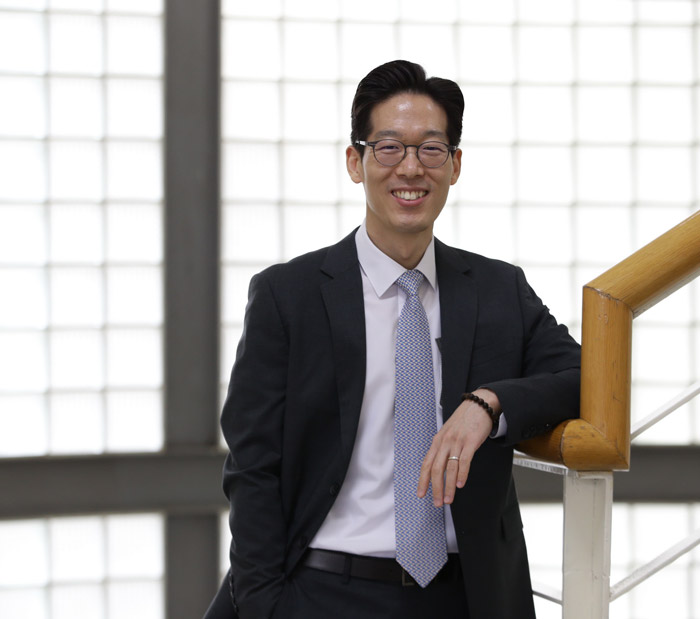
Business Administration OH, JONG MIN Prof.
Technological Fit and the Market for Managerial Talent
Last June, Benedetto Vigna became the new CEO of Ferrari NV, joining the company from semiconductor manufacturer STMicroelectronics NV. The chairman of Ferrari noted Vigna’s “deep understanding of the technologies driving much of the change in our industry,” and the subsequent press release stressed Vigna’s experience “at the heart of the semiconductor industry that is rapidly transforming the automotive sector.” The emphasis on the new CEO’s technological background was emblematic of an important yet underexplored development: the growing impact of technological expertise on the executive labor market. In a new paper, we examine whether the degree to which companies share an expertise in technology drives competition for managers and, hence, compensation. Our focus is based on the notion that firms with similar technologies are likely to value similar managerial attributes. As CEOs gain experience with and knowledge of the businesses they run, they are also likely to gain expertise in technological domains associated with managing firms in certain technological areas. Therefore, managers’ expertise in certain technological domains is valuable not only to their firm but also to other firms that focus on similar technology. This will ultimately be manifested in CEO compensation policies. Studies show that a manager’s technological expertise plays an important role in determining how much the manager and his firm complement each other. Our focus on the role of technological-expertise similarities in shaping firms’ compensation policies is also consistent with how many proxy statements treat technological considerations as important in choosing peer groups for benchmarking executive compensation. We use patent technology classifications to measure firms’ technological expertise and their similarities. Using compensation-benchmarking peer-firm data and the technological overlap measure, we begin by showing that similarity in technological expertise is a significant determinant of whether a certain firm is used as a compensation benchmarking peer. Moreover, even within the same industry and size groups, we show that a firm’s choice of peer firms is determined by its technological similarity to those firms. Our results suggest that technological similarity plays a crucial role in firms’ choice of peer group and that considering the role of technological fit is critical for demonstrating the efficiency of the labor market and the composition of the peer group. We then present evidence consistent with compensation benchmarking being an efficient approach to estimating the market wage for human capital, as opposed to its use reflecting managerial opportunism. We show that higher technological similarity with benchmarking peer firms increases the likelihood that a CEO who received above-median (below-median) pay in the previous year received at or below-median (above-median) pay in the following year. This result is obtained even after controlling for other important compensation determinants from previous studies, and is consistent with the market-based theory of CEO compensation in that firms set CEO pay to remain competitive with firms that are competing for similar managerial talent. After establishing that technological similarity has an important effect on CEO compensation benchmarking patterns, we provide evidence that its use reflects CEOs’ outside options. In particular, we show that an increase in technological similarity increases the likelihood of the CEO joining a similar firm. Our finding reflects the notion that the marketability of CEOs’ technological expertise is at least partly reflected in firms’ technological similarity and that firms prefer to hire CEOs with a better technological fit. Furthermore, we show that the CEO compensation levels of technologically similar peer firms are positively associated with CEO pay at the focal firm. We thus provide evidence that technological similarity plays a crucial role in the market for CEO talent and that the labor market consistently reflects CEOs’ outside opportunities. Overall, our study contributes to the literature focusing on the effect of similarities in technological expertise on corporate policies, shows that technological expertise is a distinct and previously overlooked aspect of transferable CEO skill, adds to the literature on optimal contracting for CEO compensation, and shows that technological similarity plays an important role in determining compensation benchmarking peers – consistent with an efficient contracting motivation. This paper is forthcoming in the one of the leading journals in the finance field, the Journal of Financial and Quantitative Analysis, and is available at the following link: https://doi.org/10.1017/S0022109022000229
- No. 194
- 2022-06-24
- 2057
-
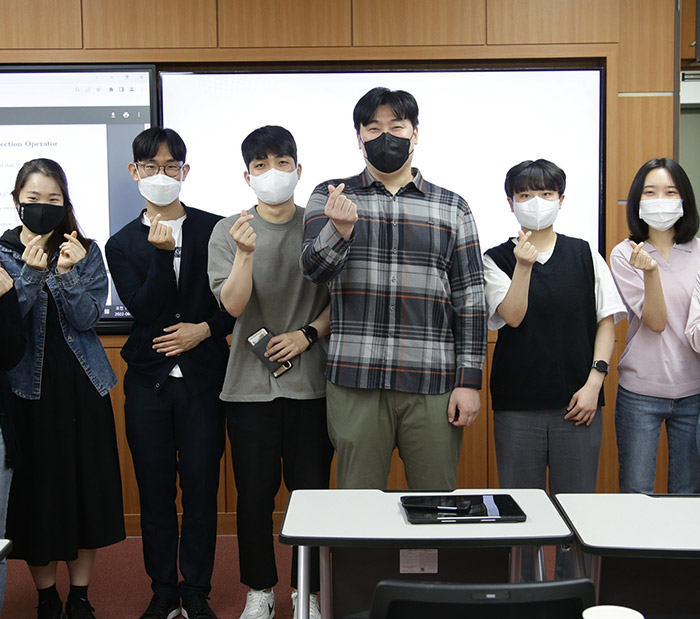
Statistics PARK, SEYOUNG Prof.
Integrating Multidimensional Data for Clustering Analysis with Applications to Cancer Patient Data
Professor Seyoung Park in the department of Statistics recently proposed the novel clustering method by integrating multi-dimensional data for clustering analysis. Advances in high-throughput genomic technologies coupled with large-scale study projects have generated rich resources of diverse types of omics data to better understand disease etiology and treatment responses. Clustering patients into subtypes with similar disease etiologies and/or treatment responses using multiple omics data has the potential to improve the precision of clustering than using a single type of omics data. However, in practice patient clustering is still mostly based on a single omics data type or ad hoc integration of clustering results from each data type, leading to potential loss of information. By treating each omic data type as a different informative representation from patients, this research proposes a novel multi-view spectral clustering framework to integrate different omics data types measured from the same subject. The proposed method learns the weight of each data type as well as a similarity measure between patients via a non-convex optimization framework. When the proposed method is applied to the TCGA data, the patient clusters inferred by the proposed method show more significant differences in survival times between clusters than those between clusters inferred from existing clustering methods. Professor Park said “The main contribution of this research is to conduct clustering analysis using multiple high-dimensional data by considering the heterogeneity of different data and learning importance of data. We expect to apply the same idea to the different statistical frameworks using multiple high-dimensional data. “ This research is published in the “Journal of the American Statistical Association”, which is the top journal in Statistics. ※ Title: Integrating multidimensional data for clustering analysis with applications to cancer patient data ※ Source: https://doi.org/10.1080/01621459.2020.1730853
- No. 193
- 2022-06-17
- 1727
-
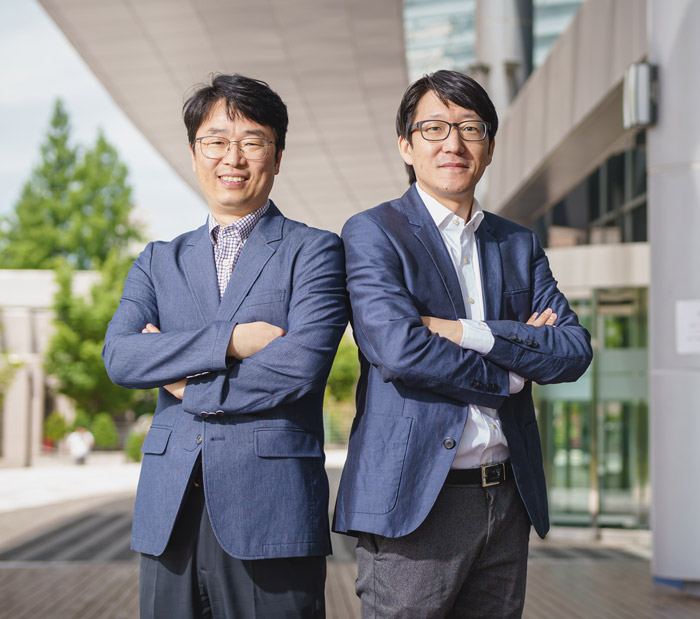
Advanced Materials Science and Engineering KIM, YUNSEOK Prof. ·Prof. Young-Min Kim
A strategy for highly enhanced ferroelectricity in HfO2-based ferroelectrics using ion bombardment
The research team* of Professor Yunseok Kim demonstrates a way to highly enhance the ferroelectricity of HfO2-based ferroelectrics using ion bombardment. * Co-corresponding authors: Prof. Young-Min Kim (SKKU), Dr. Jinseung Heo (Samsung Advanced Institute of Technology), Dr. Sergei Kalinin (Oak Ridge National Laboratory, USA) Continuous advancement in nonvolatile and morphotropic beyond-Moore electronic devices necessitates the development of strategies that utilize the wealth of functionalities of complex materials at extremely reduced dimensions. The discovery of ferroelectricity in hafnium oxide (HfO2)–based ferroelectrics that are compatible with the semiconductor process has opened interesting and promising avenues of research. However, the origins of ferroelectricity and pathways to controlling it in HfO2-based ferroelectrics are still mysterious. We report that local ion bombardment can activate ferroelectricity in these materials. The possible competing mechanisms, including ion-induced molar volume changes, vacancy redistribution, vacancy generation, and activation of vacancy mobility, are discussed. These findings including the variation of ferroelectricity through defect engineering based on ion bombardment suggest additional possibilities for ferroelectricity enhancement in HfO2-based ferroelectrics. Furthermore, this approach can be directly applied to a semiconductor process without structural modification and, thus, can increase its applicability in next-generation electronic devices, such as ultra-scaled ferroelectrics-based transistors and memories. [Paper] - “Highly enhanced ferroelectricity in HfO2-based ferroelectric thin film by light ion bombardment”, Science 376(6594), 731-738 (2022) - URL: https://www.science.org/doi/10.1126/science.abk3195 □ Webpage: http://spm.skku.edu
- No. 192
- 2022-06-17
- 1556
-

Chemistry KO, DOO HYUN Prof. ·Chihyung Lee, Jung-Hyun Lee
Development of high-performance organic photovoltaics under low light environments through controlling the morphology of
On April 22, 'Over 30% efficient indoor organic photovoltaics enabled by morphological modification using two compatible non-fullerene acceptors' written by Professor Doo-Hyun Ko's research party was recognized for excellent research and was published in 'Advanced Energy Materials (IF=29.368)', a world-renowned academic journal. Professor Ko’s research party demonstrated an indoor organic photovoltaic cell that achieves power conversion efficiency exceeding 30% by introducing an organic photoactive layer that enables efficiently harvesting the photons under the indoor environment of low irradiance. The research results of the high-performance indoor organic photovoltaic cells are expected to be utilized in the indoor Internet of Things and smart-farm fields that require a continuous power supply. The photovoltaic efficiency is determined by effectively extracting the charge carriers, generated inside the photoactive layer of the photovoltaic cell, toward the electrode without recombination loss. Notably, under indoor lighting in which intensities are 10-100 times lower relative to the sunlight, charge carrier loss significantly contributes to a decrease in the power conversion efficiency. In this study, the photoactive layer was fabricated by blending two well-miscible non-fullerene acceptors and polymer donors. The introduced photoactive layer features nanoscale phase separation between donor and acceptor with high para-crystallinity. Through these separated donor and acceptor phases, the positive (hole) and negative charge (electron) carriers can be transported toward the electrode without recombination loss, respectively. Thereby, the organic photovoltaic cells reported by Professor Ko’s research party achieved a power conversion efficiency of over 30% under indoor circumstances of low irradiance by fabricating the superior photoactive layer. Participating researchers and authors: Chihyung Lee (co-first author, SKKU, Ph.D. candidate), Jung-Hyun Lee (co-first author, SKKU, master course), Hyun Hwi Lee (second author, Pohang Accelerator Research Institute, researcher), Minwoo Nam (corresponding author, Sangji University, assistant professor), Doo-Hyun Ko (corresponding author, SKKU, associate professor). [Figure 1] (a) Image of organic photovoltaic under low light conditions. (b) AFM image of donor and acceptor phase separation through morphology controlling photoactive layer. (c) J-V characteristics of organic photovoltaic under low light environment (250, 500, and 1000 lux 3000 K LED)
- No. 191
- 2022-06-03
- 1373
-
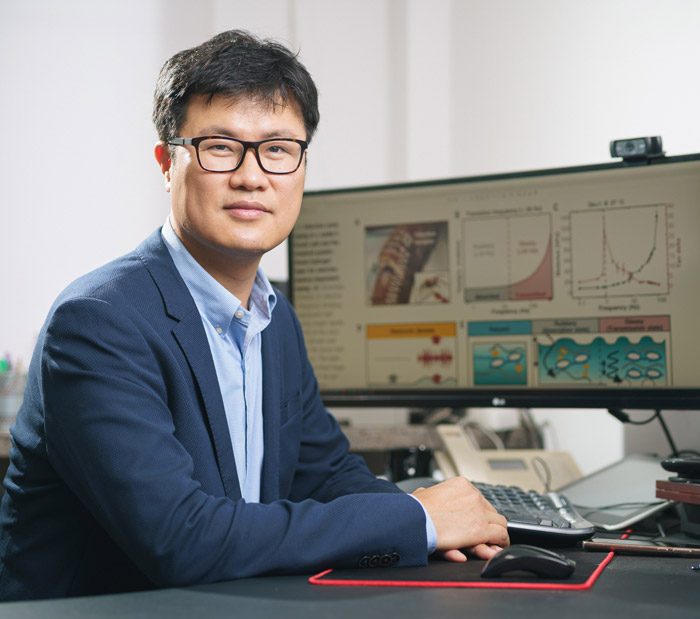
Chemical Engineering KIM, TAE IL Prof.
Research in Advanced Noise-Selective Damping Hydrogel published in Science
SKKU School of Chemical Engineering Professor Tae-il Kim’s research team, led by Dr. Byeong-hak Park, succeeded in developing a damping material that selectively removes external noise by mimicking the pad of a spider’s leg and an electronic device using it. Recently, bioelectronic devices, including commercially available smartwatches and smartphones, measure important bio-signals in the form of being attached to or inserted into the body. A lot of research has been done to improve device performance for more precise measurement, but as the device performance increases, there is a problem in that when measuring biological signals, interference from various biological signals, including unconscious noise, makes it difficult to distinguish signals. In particular, general noises such as simple walking and movement have a band of less than 30 Hz and are inevitably one of the factors that obstruct the collection of bio-signals. In the current research stage to reduce noise, including commercialized electronic devices, signal processing technology, and machine learning-based signal classification using the same are heavily concentrated. However, this causes signal distortion, requires additional circuitry, and has disadvantages in that it is difficult to change the signal band immediately. In addition, other damping materials have a problem in that they are not optimized for selective bio-signal collection. Therefore, there is a need for a material that passes a bio-signal having a relatively high-frequency band and selectively damps noises having a low-frequency band. Therefore, the research team tried to solve the above problems with inspiration from natural materials. In the case of spiders, they have very sensitive vibration receptors, so they can sensitively receive vibration signals from enemies, prey, or mates. In particular, the signal can be read well even from external noise such as wind or rain, because the viscoelastic pad located in front of the vibration receptor selectively damps the low-frequency signal. Based on this, the research team produced a gelatin/chitosan-based viscoelastic hydrogel by simulating the principle of a spider’s pad. In the case of the spider’s pad, it is hypothesized that chitin is composed of a sugar and protein, and in the case of chitin, many hydrogen bonds are formed between adjacent polymer chains, and in the case of proteins, it is hypothesized that a phase change is induced between the chains. In fact, it was confirmed that the gelatin/chitosan-based viscoelastic hydrogel had higher damping energy and selectivity than other damping materials. In addition, it was confirmed that the damping range can be adjusted in real-time from about 1 Hz to 50 Hz when the temperature is externally controlled to 45 degrees. Using this, combined with a strain sensor, mechanical bio-signals such as neck vibration and heart rate can be read with a high signal-to-noise ratio under noise, and electrical bio-signals such as electrocardiogram and brainwaves can also be stably detected under noise. By using signal processing to obtain a higher signal-to-noise ratio than the existing method that removes noise, it has been proven that the material selectively damping the noise is much more effective than the existing method. Professor Tae-il Kim said, “This study is a case of materially solving the chronic noise problem of existing electronic devices by mimicking the special mechanical properties of spiders in nature. Selectively reducing external noise can be a more effective method of collecting bio-signals.” In addition, he explained the significance of the study and follow-up research plans. Saying, “by minimizing noise, bio-signal monitoring research has been activated, and it is expected that sensitive signals that were difficult to obtain in real-time will be read out and be of great use in diagnosis and biomedical engineering.” (Image 1) Selective noise damping in a spider's cuticular pad and the bioinspired gelatin-chitosan hydrogel damper for selective frequency-dependent damping (Image 2) Demonstration of dynamic noise-damping by using the hydrogel damper for high SNR detection of biophysiological signals
- No. 190
- 2022-05-30
- 1406
-
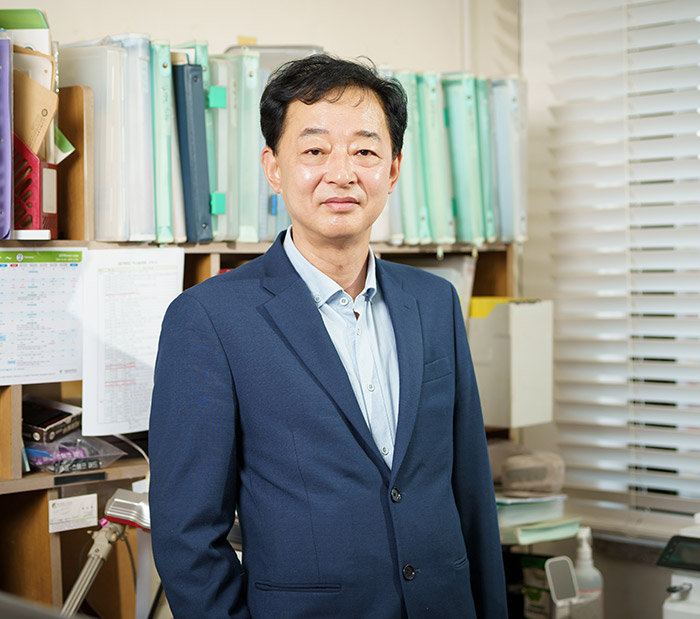
Chemical Engineering NAM, JAEDO Prof. ·Uiseok Hwang
Smart polymer-based composites for frequency-selective electromagnetic interference shielding
Prof. Jae Do Nam's research team (Functional nanocomposite lab., first author Uiseok Hwang) developed polymer-based composites with frequency-selective electromagnetic shielding (EMI) capabilities and presented a new breakthrough in aerospace material technologies such as stealth aircraft, satellites, etc. Recently, as various electromagnetic (EM) waves exist over a broad frequency spectrum generated from electronic devices, autonomous vehicles, and 5G communication, there is a need for a material capable of selectively shielding EM waves of the desired frequency range. Unfortunately, such technology has rarely been reported because most EMI shielding materials exhibit low-frequency selectivity. The research team found that when spherical particles with wave-reflecting and -absorbing abilities are mixed and applied as polymer-based composites, EM waves in different frequency ranges can be selectively absorbed depending on their mixing ratio and arrangement in the matrix. The composite materials presented in this study can be used as Radar Absorbing Materials (RAMs) for stealth aircraft. The materials can selectively shield the undesirable EM waves in enemy radar frequency ranges and transmit them in telecommunication frequency ranges, enabling the pilots to smoothly communicate without device malfunction and detection from the enemy. This work was supported by projects from the U.S. Air Force Office of Scientific Research/AOARD and Center for Composite Materials & Concurrent Design (Director Prof. Jonghwan Suhr) and published as a front cover in the Journal of Materials Chemistry A (IF: 12.732), a prominent international journal in the field of materials research. [Research Overview] Aperture control in polymer-based composites and frequency-selective EM wave absorption characteristics [Journal Front Cover] ※ Title: Aperture control in polymer-based composites with hybrid core-shell spheres for frequency-selective electromagnetic interference shielding ※ DOI: https://doi.org/10.1039/D2TA00045H
- No. 189
- 2022-05-20
- 1347
-

Graduate School of Governance LEE, DONG SEONG Prof.
Research of promotion rates among gender with 515 ministers appointed since the 1988 democratization in Korea
Professor Dong Seong (Don) Lee’s (Graduate School of Governance / Department of Public Administration)'s research introduced in the Washington Post Professor Lee has published a co-authored article in COMPARATIVE POLITICAL STUDIES (ranked top 8% among SSCI journals), titled “Breaking the Cabinet’s Glass Ceiling: The Gendered Effect of Political Experience in Presidential Democracies. The research examines whether women face discrimination in their political careers after their initial cabinet appointment. With new data on the careers of all 1,374 ministers who have held office in the major presidential democracies in Asia, including the 515 ministers who have served in Korea since the 1988 democratization, he tests for gendered patterns in “cabinet promotions”—instances where a president approves the transfer of a minister from their initial appointment to a higher-prestige executive post, one with access to greater power and financial resources. Overall, the results show that male and female cabinet ministers experience surprisingly similar promotion rates. At first glance, this may indicate that most gender discrimination occurs at the appointment stage and that afterward, there is more gender parity. However, while the overall promotion rates may be similar across genders, there are significant differential effects of political experience on the likelihood of men and women receiving a promotion. For female ministers, having a political background increases the chance of promotion by 17 percentage points more than it does for male ministers. The political experience thus matters much more for women’s upward mobility in cabinets than men. This research was introduced in the Washington Post (Post) as an article titled “South Korea’s new leader says there’s no gender inequality problem,” which links to the Post’s recent interview with South Korea’s president-elect, Yoon Suk-yeol. According to the article posted in the Post, in contrast to Yoon’s assertion that systemic gender inequality is “a thing of the past” in his country, significant gender discrimination exists in presidential cabinets in South Korea, as shown by Professor Lee’s research findings. The Post’s article concludes that the South Korean cabinets may become more balanced over time as more women gain cabinet positions. But that will be only feasible when presidents place more excellent value on having a gender balance in their cabinet and empowering gateway ministries, such as a women’s affairs ministry, to help more women initiate and build their cabinet careers.
- No. 188
- 2022-05-13
- 2944
-
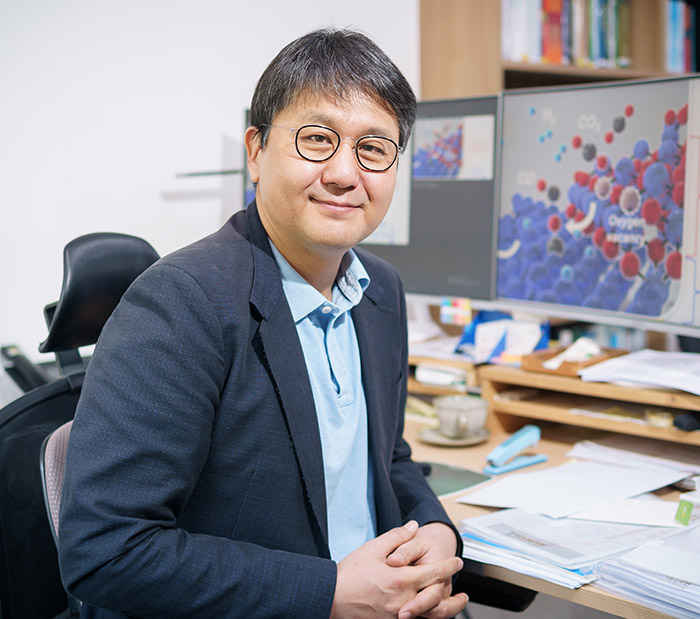
Mechanical Engineering KIM, JAEHOON Prof. ·Dr. Muhammad Kashif Khan, Dr. Malayil Gopalan Sibi, Dr. Deepak Verma, Researcher Heun Tae Cho, Researcher Won Joong Yoon
Synthesis of liquid fuel and value-added chemicals directly from carbon dioxide, the main culprit of greenhouse gas
Due to the industrial revolution using coal in the mid-18th century and the discovery of crude oil in the 19th century, humankind has made rapid progress by developing technologies to mass-produce cheap fuels and chemicals. Korea also ranks 5th in the world for its heavy chemical industry development strategy in the 1970s and has the 8th largest oil refining industry in the world.In the 20th century, rapid economic development was achieve globally through the use of fossil fuels such as crude oil and coal, but as a reward, the concentration of CO2 in the atmosphere increased day by day and reached 420 ppm. It has reached a stage that threatens the survival of humankind, such as global warming, ecosystem destruction, sea-level rise and seawater acidification. ProfessorJae-Hoon Kim's research team (Department of Mechanical Engineering) at Sungkyunkwan University has developed a technology that can selectively produce fuels and value-added chemicals by reacting carbon dioxide emitted from industry with renewable hydrogen. The research is expected to contribute to mitigating climate change. The research team developed a technology for synthesizing C5+ long-chain hydrocarbons that can be used as fuel for gasoline and diesel with high selectivity of 77.0% from CO2 using an iron-based catalyst (Na-FeAlOx) with an alumina promoter. The results were published in ACS Catalysis at 2020 [ACS Catalysis, 2020, 10, 10325−10338]. Through this study, the research team identified the principle of the synthesis mechanism of alpha-olefin, a precursor of aromatic compounds, in iron-based catalysts. [Reaction mechanism of CO2 in the Na-FeAlOx catalyst] The research team confirmed that it was possible to produce aromatic compounds from carbon dioxide with a high CO2 conversion rate of 45% and a high aromatic selectivity of 39% by using a composite catalyst combining iron-based catalyst and zeolite. The results were published in Applied Catalysis B:Environmental at 2022 [Applied Catalysis B: Environmental, 2022, 301, 120813]. In particular, the selectivity of BTX among aromatic compounds was high at 59% by controlling the acid site of zeolite. The highly value-added aromatic compound refers to benzene, toluene, xylene, etc. These essential chemical materials rank first in total petro chemical production. [Na-FeAlOx/zeolite Synthesis of aromatic compounds directly from CO2 in complex catalysts] In addition, the research team developed the world's first process that can operate for over 1425 hours with a high yield of about 20% of C5+ long-chain hydrocarbons from CO2 using a cobalt-based catalyst. The results were published in Applied Catalysis B: Environmental at 2022 [AppliedCatalysis B: Environmental, 2022, 305, 121041]. Furthermore, the cobalt-based catalyst newly developed by the research team laid the foundation for the production of promising liquid fuels and lube base oils because the catalysts exhibit high C5+ and C21+ selectivity in the conversion of CO2. In addition, the research team designed a nickel-zinc alloy catalyst capable of synthesizing high value-added chemical materials such as acetic acid and propionic acid by direct hydrogenation of CO2, and published the results in ACS Catalysis at 2021 [ACS Catalysis, 2021, 11,8382–8398]. [Mechanism of direct long-chain hydrocarbon synthesis from CO2 using Na-CoMnOxcatalyst] Currently,Professor Jae-Hoon Kim's research team is researching the possibility ofcommercialization in collaboration with a domestic oil refinery. It intends tocontribute to reducing national greenhouse gases in the future.
- No. 187
- 2022-05-06
- 2895
